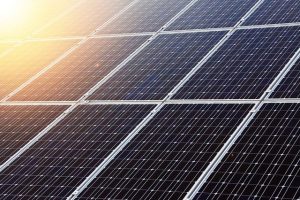
Gemini, a massive new solar+storage facility in Nevada, is a bright spot for an industry that has faced numerous challenges and setbacks.
Financing a billion-dollar project and selecting vendors
The Gemini project’s debt financing includes a $1.3 billion construction/term loan, a tax-equity bridging loan, and a letter of credit facility. Quinbrook said the tax equity commitments total $532 million, making it one of the largest single-asset tax equity solar financings ever done in the US.
Primergy chose Kiewit Power Constructors as Gemini’s EPC partner and IHI Terrasun Solutions as the project’s lithium-ion battery integrator. Gemini can generate power all year, but its battery will be critical from 4 p.m. to 9 p.m. during the summer.
It will feature high-efficiency mono-PERC solar cells manufactured by Maxeon Solar Technologies in Malaysia and constructed by Maxeon in Mexicali, Mexico (for the tariff-minded). The panels will be delivered in four quarters starting in 2022 and finishing in 2023, when the project is expected to be completed.
It will use single-axis solar trackers from Array Technologies. Chief revenue officer Travis Rose said the tracker firm worked closely with the EPC, Keiwit, to optimize the centralized tracker architecture and minimize grading. Array’s architecture uses longer tracker rows with less foundations. Array says it plans to source up to 90% of the project’s materials domestically.
This will support up to 1,100 more employment in the local region and pump an estimated $712.5 million into the economy during construction.
Desert tortoises and milkvetch
Building a 7,100-acre renewable energy project on vulnerable desert territory unavoidably causes environmental concerns.
“We are utilizing the latest research and design considerations to minimize the footprint of Gemini,” says Primergy. It also claims to have reduced the planned footprint of Gemini by over 20% and the need for access roads by 25% compared to standard solar projects.
Despite these assurances, the project’s final environmental impact statement recognizes the loss of at least 215 adult and 900 baby desert tortoises, as well as animals. Rare plants, like the threecorner milkvetch, may also be threatened by building.
“While Native American communities and environmental conservation organizations oppose the project, it was approved and will be built,” the Environmental Justice Atlas states.
What’s the future for projects like Gemini?
The US and worldwide solar sectors have endured a decade of market and policy problems. In a report by the Solar Energy Industries Association and Wood Mackenzie, installed solar capacity in the US reached 100 gigawatts, and projects with capacities higher than 100 megawatts are increasing across the country.
Until recently, the pattern seemed destined to continue. S&P Global Market Intelligence predicted late last year that 44 gigawatts of new solar would be installed in the US in 2022, nearly double the 23 gigawatts added in 2021.
That was before the Auxin Solar trade petition threatened the industry.
Now that the solar sector is facing new tariffs, supply-chain issues, and pandemic threats, the Gemini project stands out as a bright spot.
“We all support American manufacturing and technology,” said Erica Brinker, Array’s chief commercial officer. We support domestic module production. But I believe we need a regulatory framework that combines the administration’s actual wishes and goals with what we need in five years. We can’t just make everything in America. That’s just not the case right now.”

